Community Engagement: Theory, Types, Challenges and Benefits Analysis
VerifiedAdded on 2022/11/10
|14
|3129
|331
Essay
AI Summary
This essay provides a comprehensive analysis of community engagement. It begins with an executive summary outlining the core themes, followed by a detailed exploration of the community engagement theory, including its definition as a dynamic process involving interaction and communication. The essay then delves into the four pillars of community engagement: Performance, Practice, People, and Policy, offering insights into how these pillars form the framework of successful engagement strategies. Furthermore, the essay examines the importance of building relationships, acting with humility, developing understanding, affirming dignity, and pursuing justice within community engagement frameworks. It also identifies and explains the various types of community engagement such as community building, community education, economic development and community organizing. The essay concludes by discussing the challenges and benefits of community engagement, such as ensuring representativeness, establishing community views, avoiding disillusionment, building community engagement skills, service flexibility, and ensuring equity. This analysis provides a thorough understanding of the multifaceted nature of community engagement and its implications for community development.
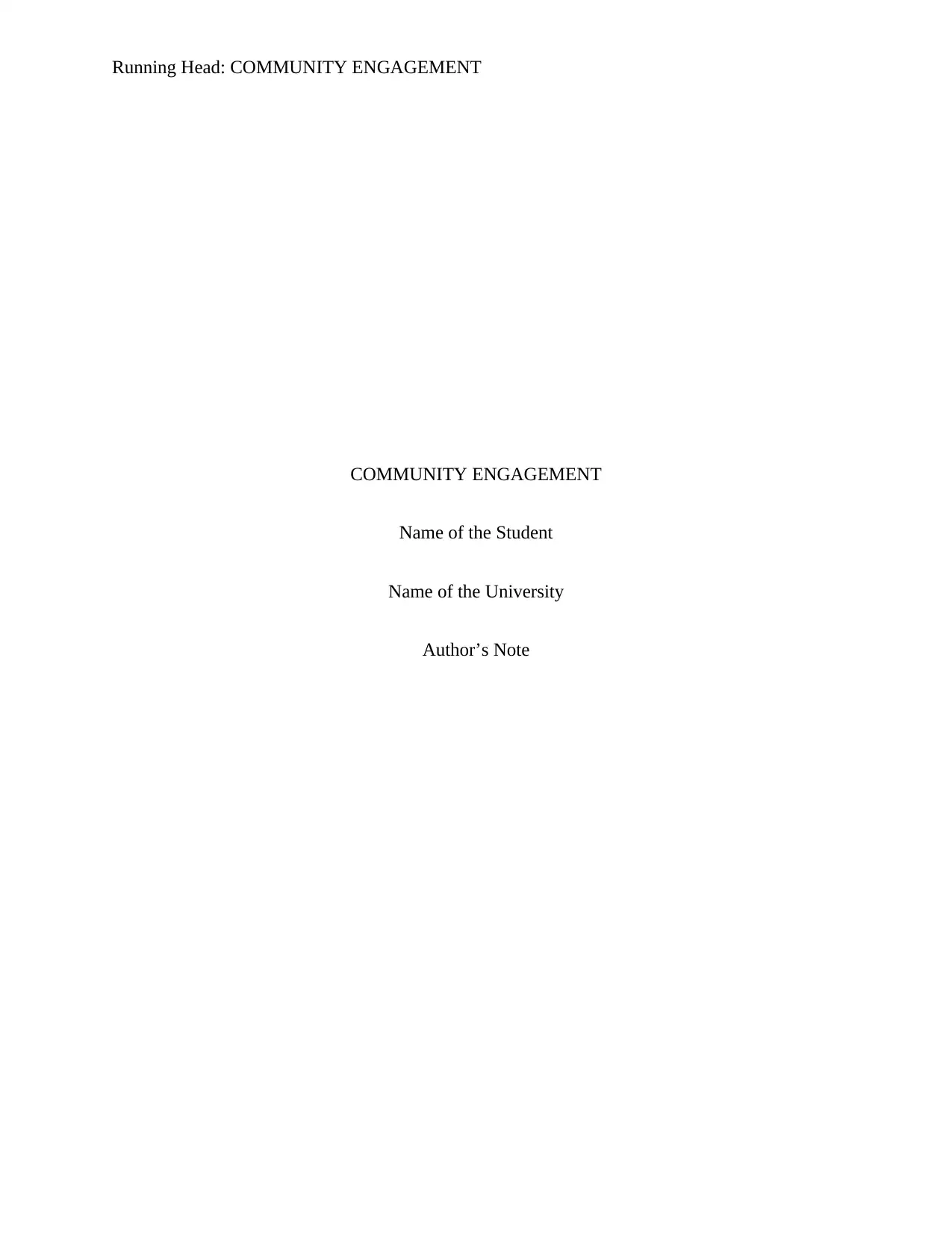
Running Head: COMMUNITY ENGAGEMENT
COMMUNITY ENGAGEMENT
Name of the Student
Name of the University
Author’s Note
COMMUNITY ENGAGEMENT
Name of the Student
Name of the University
Author’s Note
Paraphrase This Document
Need a fresh take? Get an instant paraphrase of this document with our AI Paraphraser
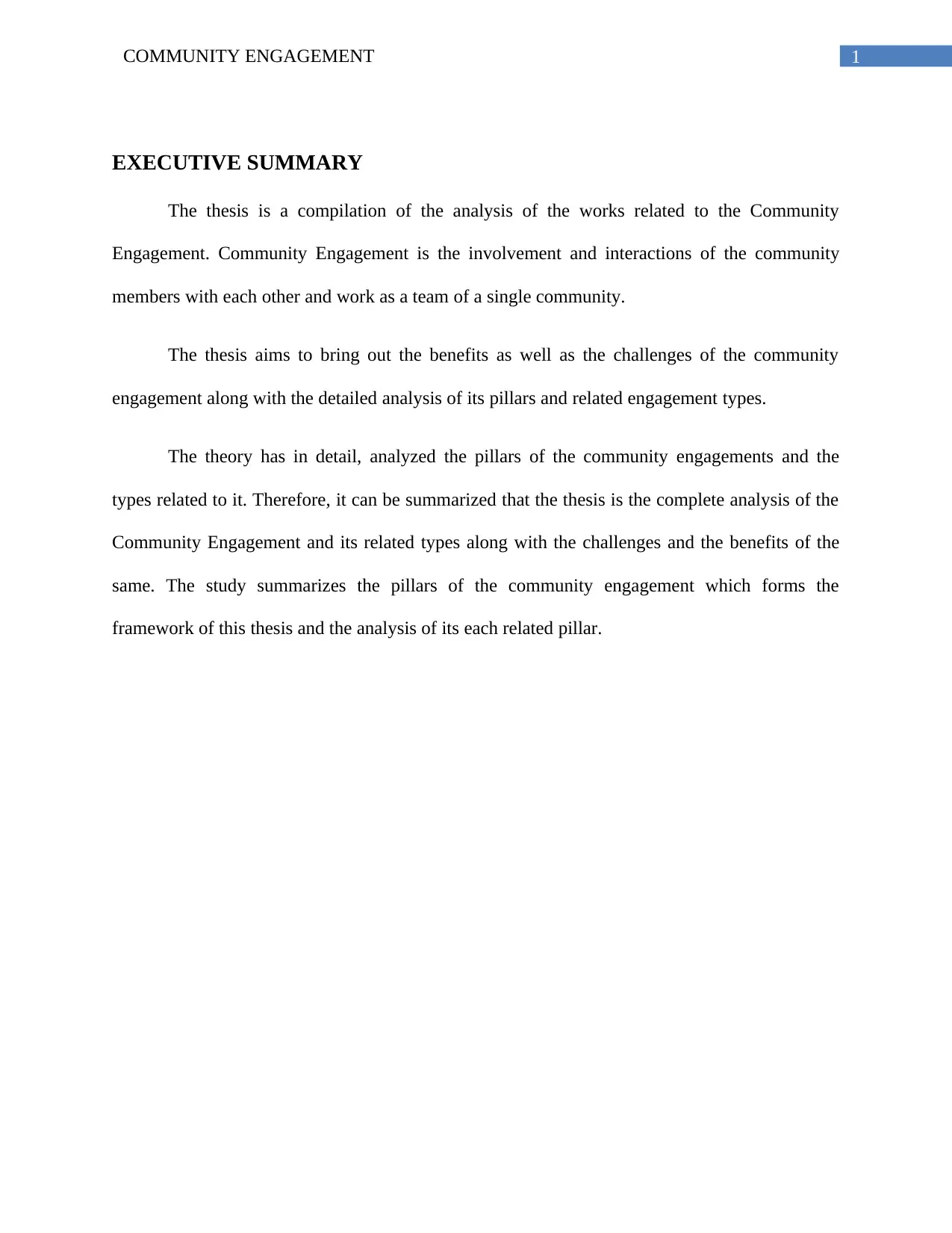
1COMMUNITY ENGAGEMENT
EXECUTIVE SUMMARY
The thesis is a compilation of the analysis of the works related to the Community
Engagement. Community Engagement is the involvement and interactions of the community
members with each other and work as a team of a single community.
The thesis aims to bring out the benefits as well as the challenges of the community
engagement along with the detailed analysis of its pillars and related engagement types.
The theory has in detail, analyzed the pillars of the community engagements and the
types related to it. Therefore, it can be summarized that the thesis is the complete analysis of the
Community Engagement and its related types along with the challenges and the benefits of the
same. The study summarizes the pillars of the community engagement which forms the
framework of this thesis and the analysis of its each related pillar.
EXECUTIVE SUMMARY
The thesis is a compilation of the analysis of the works related to the Community
Engagement. Community Engagement is the involvement and interactions of the community
members with each other and work as a team of a single community.
The thesis aims to bring out the benefits as well as the challenges of the community
engagement along with the detailed analysis of its pillars and related engagement types.
The theory has in detail, analyzed the pillars of the community engagements and the
types related to it. Therefore, it can be summarized that the thesis is the complete analysis of the
Community Engagement and its related types along with the challenges and the benefits of the
same. The study summarizes the pillars of the community engagement which forms the
framework of this thesis and the analysis of its each related pillar.
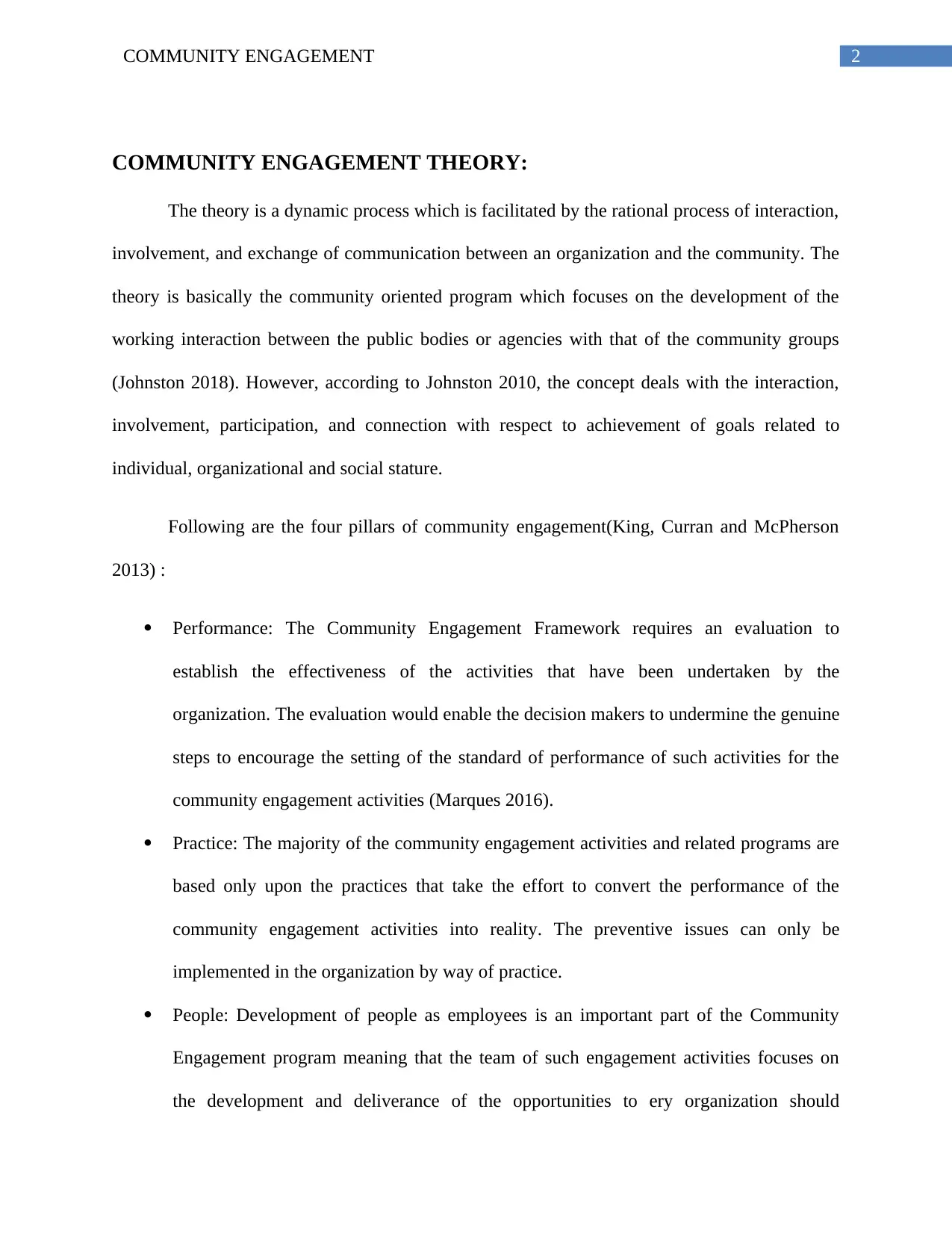
2COMMUNITY ENGAGEMENT
COMMUNITY ENGAGEMENT THEORY:
The theory is a dynamic process which is facilitated by the rational process of interaction,
involvement, and exchange of communication between an organization and the community. The
theory is basically the community oriented program which focuses on the development of the
working interaction between the public bodies or agencies with that of the community groups
(Johnston 2018). However, according to Johnston 2010, the concept deals with the interaction,
involvement, participation, and connection with respect to achievement of goals related to
individual, organizational and social stature.
Following are the four pillars of community engagement(King, Curran and McPherson
2013) :
Performance: The Community Engagement Framework requires an evaluation to
establish the effectiveness of the activities that have been undertaken by the
organization. The evaluation would enable the decision makers to undermine the genuine
steps to encourage the setting of the standard of performance of such activities for the
community engagement activities (Marques 2016).
Practice: The majority of the community engagement activities and related programs are
based only upon the practices that take the effort to convert the performance of the
community engagement activities into reality. The preventive issues can only be
implemented in the organization by way of practice.
People: Development of people as employees is an important part of the Community
Engagement program meaning that the team of such engagement activities focuses on
the development and deliverance of the opportunities to ery organization should
COMMUNITY ENGAGEMENT THEORY:
The theory is a dynamic process which is facilitated by the rational process of interaction,
involvement, and exchange of communication between an organization and the community. The
theory is basically the community oriented program which focuses on the development of the
working interaction between the public bodies or agencies with that of the community groups
(Johnston 2018). However, according to Johnston 2010, the concept deals with the interaction,
involvement, participation, and connection with respect to achievement of goals related to
individual, organizational and social stature.
Following are the four pillars of community engagement(King, Curran and McPherson
2013) :
Performance: The Community Engagement Framework requires an evaluation to
establish the effectiveness of the activities that have been undertaken by the
organization. The evaluation would enable the decision makers to undermine the genuine
steps to encourage the setting of the standard of performance of such activities for the
community engagement activities (Marques 2016).
Practice: The majority of the community engagement activities and related programs are
based only upon the practices that take the effort to convert the performance of the
community engagement activities into reality. The preventive issues can only be
implemented in the organization by way of practice.
People: Development of people as employees is an important part of the Community
Engagement program meaning that the team of such engagement activities focuses on
the development and deliverance of the opportunities to ery organization should
⊘ This is a preview!⊘
Do you want full access?
Subscribe today to unlock all pages.

Trusted by 1+ million students worldwide
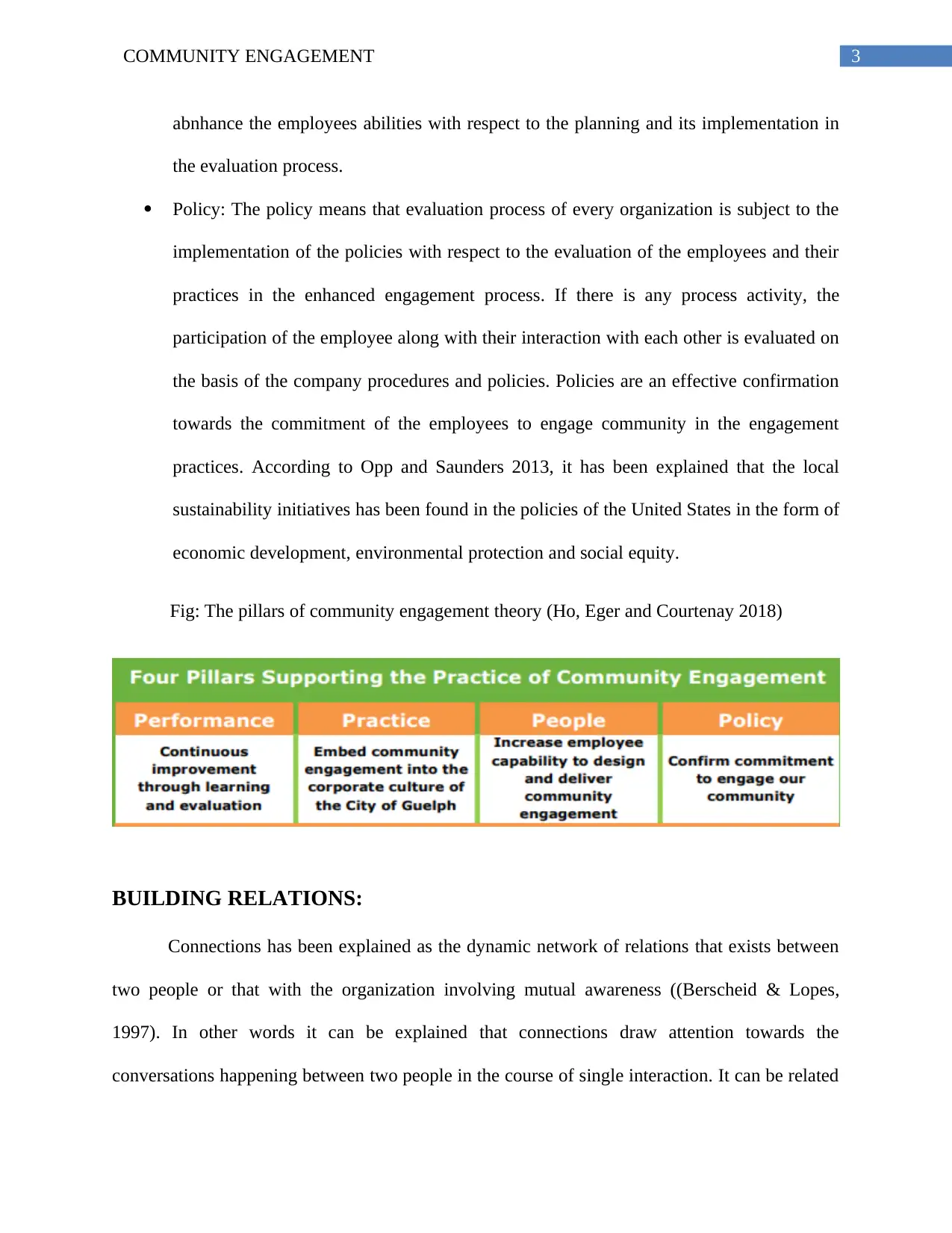
3COMMUNITY ENGAGEMENT
abnhance the employees abilities with respect to the planning and its implementation in
the evaluation process.
Policy: The policy means that evaluation process of every organization is subject to the
implementation of the policies with respect to the evaluation of the employees and their
practices in the enhanced engagement process. If there is any process activity, the
participation of the employee along with their interaction with each other is evaluated on
the basis of the company procedures and policies. Policies are an effective confirmation
towards the commitment of the employees to engage community in the engagement
practices. According to Opp and Saunders 2013, it has been explained that the local
sustainability initiatives has been found in the policies of the United States in the form of
economic development, environmental protection and social equity.
Fig: The pillars of community engagement theory (Ho, Eger and Courtenay 2018)
BUILDING RELATIONS:
Connections has been explained as the dynamic network of relations that exists between
two people or that with the organization involving mutual awareness ((Berscheid & Lopes,
1997). In other words it can be explained that connections draw attention towards the
conversations happening between two people in the course of single interaction. It can be related
abnhance the employees abilities with respect to the planning and its implementation in
the evaluation process.
Policy: The policy means that evaluation process of every organization is subject to the
implementation of the policies with respect to the evaluation of the employees and their
practices in the enhanced engagement process. If there is any process activity, the
participation of the employee along with their interaction with each other is evaluated on
the basis of the company procedures and policies. Policies are an effective confirmation
towards the commitment of the employees to engage community in the engagement
practices. According to Opp and Saunders 2013, it has been explained that the local
sustainability initiatives has been found in the policies of the United States in the form of
economic development, environmental protection and social equity.
Fig: The pillars of community engagement theory (Ho, Eger and Courtenay 2018)
BUILDING RELATIONS:
Connections has been explained as the dynamic network of relations that exists between
two people or that with the organization involving mutual awareness ((Berscheid & Lopes,
1997). In other words it can be explained that connections draw attention towards the
conversations happening between two people in the course of single interaction. It can be related
Paraphrase This Document
Need a fresh take? Get an instant paraphrase of this document with our AI Paraphraser
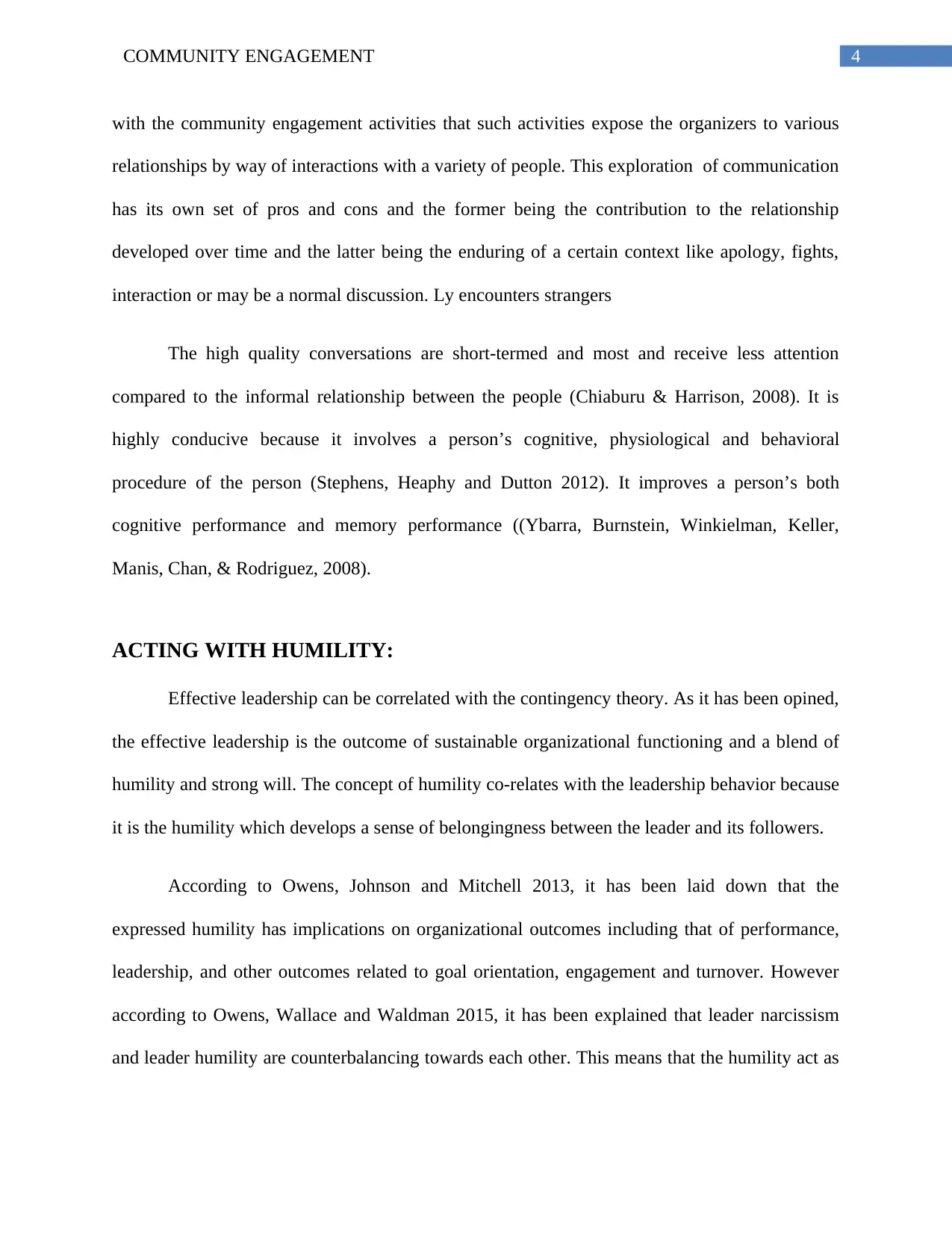
4COMMUNITY ENGAGEMENT
with the community engagement activities that such activities expose the organizers to various
relationships by way of interactions with a variety of people. This exploration of communication
has its own set of pros and cons and the former being the contribution to the relationship
developed over time and the latter being the enduring of a certain context like apology, fights,
interaction or may be a normal discussion. Ly encounters strangers
The high quality conversations are short-termed and most and receive less attention
compared to the informal relationship between the people (Chiaburu & Harrison, 2008). It is
highly conducive because it involves a person’s cognitive, physiological and behavioral
procedure of the person (Stephens, Heaphy and Dutton 2012). It improves a person’s both
cognitive performance and memory performance ((Ybarra, Burnstein, Winkielman, Keller,
Manis, Chan, & Rodriguez, 2008).
ACTING WITH HUMILITY:
Effective leadership can be correlated with the contingency theory. As it has been opined,
the effective leadership is the outcome of sustainable organizational functioning and a blend of
humility and strong will. The concept of humility co-relates with the leadership behavior because
it is the humility which develops a sense of belongingness between the leader and its followers.
According to Owens, Johnson and Mitchell 2013, it has been laid down that the
expressed humility has implications on organizational outcomes including that of performance,
leadership, and other outcomes related to goal orientation, engagement and turnover. However
according to Owens, Wallace and Waldman 2015, it has been explained that leader narcissism
and leader humility are counterbalancing towards each other. This means that the humility act as
with the community engagement activities that such activities expose the organizers to various
relationships by way of interactions with a variety of people. This exploration of communication
has its own set of pros and cons and the former being the contribution to the relationship
developed over time and the latter being the enduring of a certain context like apology, fights,
interaction or may be a normal discussion. Ly encounters strangers
The high quality conversations are short-termed and most and receive less attention
compared to the informal relationship between the people (Chiaburu & Harrison, 2008). It is
highly conducive because it involves a person’s cognitive, physiological and behavioral
procedure of the person (Stephens, Heaphy and Dutton 2012). It improves a person’s both
cognitive performance and memory performance ((Ybarra, Burnstein, Winkielman, Keller,
Manis, Chan, & Rodriguez, 2008).
ACTING WITH HUMILITY:
Effective leadership can be correlated with the contingency theory. As it has been opined,
the effective leadership is the outcome of sustainable organizational functioning and a blend of
humility and strong will. The concept of humility co-relates with the leadership behavior because
it is the humility which develops a sense of belongingness between the leader and its followers.
According to Owens, Johnson and Mitchell 2013, it has been laid down that the
expressed humility has implications on organizational outcomes including that of performance,
leadership, and other outcomes related to goal orientation, engagement and turnover. However
according to Owens, Wallace and Waldman 2015, it has been explained that leader narcissism
and leader humility are counterbalancing towards each other. This means that the humility act as
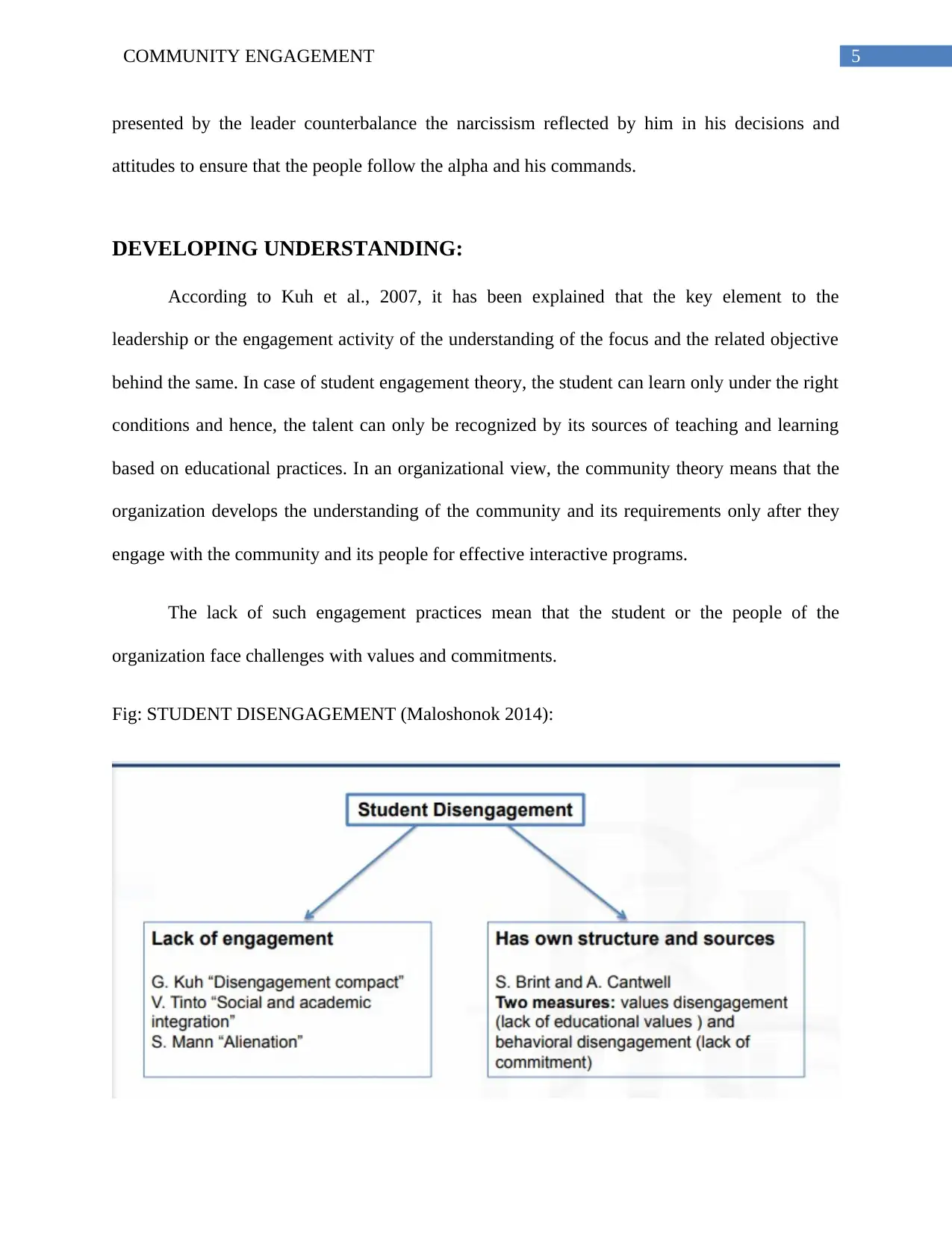
5COMMUNITY ENGAGEMENT
presented by the leader counterbalance the narcissism reflected by him in his decisions and
attitudes to ensure that the people follow the alpha and his commands.
DEVELOPING UNDERSTANDING:
According to Kuh et al., 2007, it has been explained that the key element to the
leadership or the engagement activity of the understanding of the focus and the related objective
behind the same. In case of student engagement theory, the student can learn only under the right
conditions and hence, the talent can only be recognized by its sources of teaching and learning
based on educational practices. In an organizational view, the community theory means that the
organization develops the understanding of the community and its requirements only after they
engage with the community and its people for effective interactive programs.
The lack of such engagement practices mean that the student or the people of the
organization face challenges with values and commitments.
Fig: STUDENT DISENGAGEMENT (Maloshonok 2014):
presented by the leader counterbalance the narcissism reflected by him in his decisions and
attitudes to ensure that the people follow the alpha and his commands.
DEVELOPING UNDERSTANDING:
According to Kuh et al., 2007, it has been explained that the key element to the
leadership or the engagement activity of the understanding of the focus and the related objective
behind the same. In case of student engagement theory, the student can learn only under the right
conditions and hence, the talent can only be recognized by its sources of teaching and learning
based on educational practices. In an organizational view, the community theory means that the
organization develops the understanding of the community and its requirements only after they
engage with the community and its people for effective interactive programs.
The lack of such engagement practices mean that the student or the people of the
organization face challenges with values and commitments.
Fig: STUDENT DISENGAGEMENT (Maloshonok 2014):
⊘ This is a preview!⊘
Do you want full access?
Subscribe today to unlock all pages.

Trusted by 1+ million students worldwide
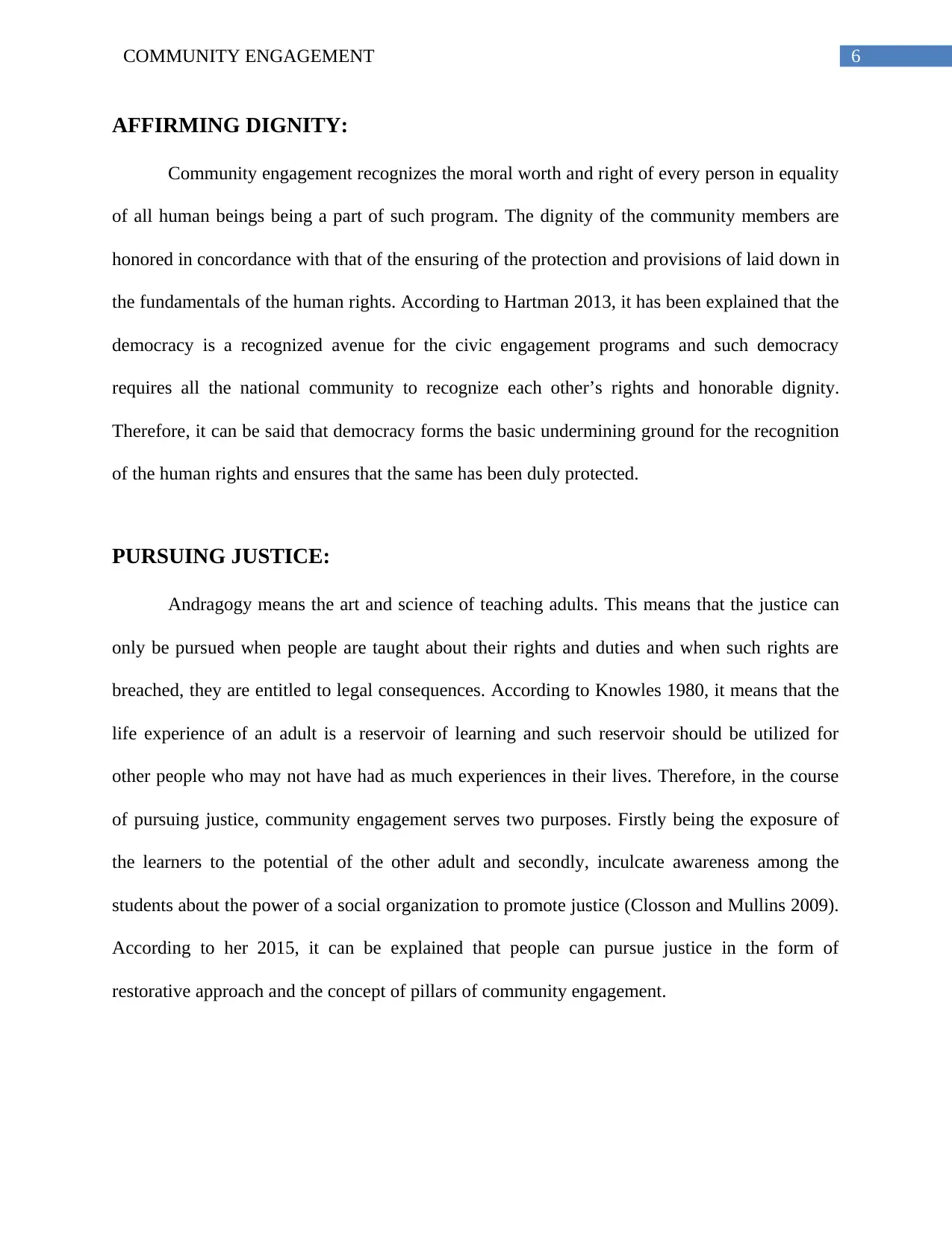
6COMMUNITY ENGAGEMENT
AFFIRMING DIGNITY:
Community engagement recognizes the moral worth and right of every person in equality
of all human beings being a part of such program. The dignity of the community members are
honored in concordance with that of the ensuring of the protection and provisions of laid down in
the fundamentals of the human rights. According to Hartman 2013, it has been explained that the
democracy is a recognized avenue for the civic engagement programs and such democracy
requires all the national community to recognize each other’s rights and honorable dignity.
Therefore, it can be said that democracy forms the basic undermining ground for the recognition
of the human rights and ensures that the same has been duly protected.
PURSUING JUSTICE:
Andragogy means the art and science of teaching adults. This means that the justice can
only be pursued when people are taught about their rights and duties and when such rights are
breached, they are entitled to legal consequences. According to Knowles 1980, it means that the
life experience of an adult is a reservoir of learning and such reservoir should be utilized for
other people who may not have had as much experiences in their lives. Therefore, in the course
of pursuing justice, community engagement serves two purposes. Firstly being the exposure of
the learners to the potential of the other adult and secondly, inculcate awareness among the
students about the power of a social organization to promote justice (Closson and Mullins 2009).
According to her 2015, it can be explained that people can pursue justice in the form of
restorative approach and the concept of pillars of community engagement.
AFFIRMING DIGNITY:
Community engagement recognizes the moral worth and right of every person in equality
of all human beings being a part of such program. The dignity of the community members are
honored in concordance with that of the ensuring of the protection and provisions of laid down in
the fundamentals of the human rights. According to Hartman 2013, it has been explained that the
democracy is a recognized avenue for the civic engagement programs and such democracy
requires all the national community to recognize each other’s rights and honorable dignity.
Therefore, it can be said that democracy forms the basic undermining ground for the recognition
of the human rights and ensures that the same has been duly protected.
PURSUING JUSTICE:
Andragogy means the art and science of teaching adults. This means that the justice can
only be pursued when people are taught about their rights and duties and when such rights are
breached, they are entitled to legal consequences. According to Knowles 1980, it means that the
life experience of an adult is a reservoir of learning and such reservoir should be utilized for
other people who may not have had as much experiences in their lives. Therefore, in the course
of pursuing justice, community engagement serves two purposes. Firstly being the exposure of
the learners to the potential of the other adult and secondly, inculcate awareness among the
students about the power of a social organization to promote justice (Closson and Mullins 2009).
According to her 2015, it can be explained that people can pursue justice in the form of
restorative approach and the concept of pillars of community engagement.
Paraphrase This Document
Need a fresh take? Get an instant paraphrase of this document with our AI Paraphraser
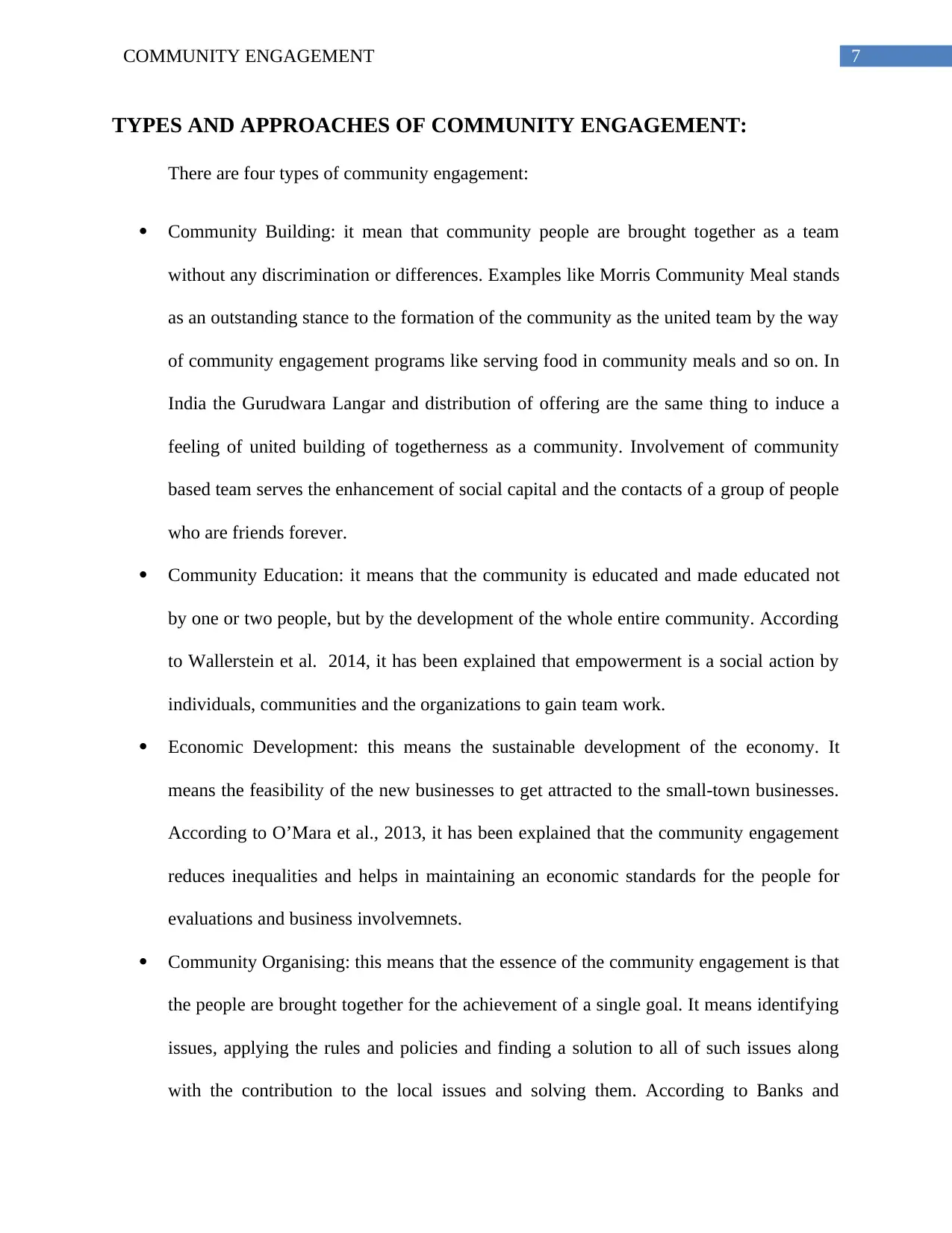
7COMMUNITY ENGAGEMENT
TYPES AND APPROACHES OF COMMUNITY ENGAGEMENT:
There are four types of community engagement:
Community Building: it mean that community people are brought together as a team
without any discrimination or differences. Examples like Morris Community Meal stands
as an outstanding stance to the formation of the community as the united team by the way
of community engagement programs like serving food in community meals and so on. In
India the Gurudwara Langar and distribution of offering are the same thing to induce a
feeling of united building of togetherness as a community. Involvement of community
based team serves the enhancement of social capital and the contacts of a group of people
who are friends forever.
Community Education: it means that the community is educated and made educated not
by one or two people, but by the development of the whole entire community. According
to Wallerstein et al. 2014, it has been explained that empowerment is a social action by
individuals, communities and the organizations to gain team work.
Economic Development: this means the sustainable development of the economy. It
means the feasibility of the new businesses to get attracted to the small-town businesses.
According to O’Mara et al., 2013, it has been explained that the community engagement
reduces inequalities and helps in maintaining an economic standards for the people for
evaluations and business involvemnets.
Community Organising: this means that the essence of the community engagement is that
the people are brought together for the achievement of a single goal. It means identifying
issues, applying the rules and policies and finding a solution to all of such issues along
with the contribution to the local issues and solving them. According to Banks and
TYPES AND APPROACHES OF COMMUNITY ENGAGEMENT:
There are four types of community engagement:
Community Building: it mean that community people are brought together as a team
without any discrimination or differences. Examples like Morris Community Meal stands
as an outstanding stance to the formation of the community as the united team by the way
of community engagement programs like serving food in community meals and so on. In
India the Gurudwara Langar and distribution of offering are the same thing to induce a
feeling of united building of togetherness as a community. Involvement of community
based team serves the enhancement of social capital and the contacts of a group of people
who are friends forever.
Community Education: it means that the community is educated and made educated not
by one or two people, but by the development of the whole entire community. According
to Wallerstein et al. 2014, it has been explained that empowerment is a social action by
individuals, communities and the organizations to gain team work.
Economic Development: this means the sustainable development of the economy. It
means the feasibility of the new businesses to get attracted to the small-town businesses.
According to O’Mara et al., 2013, it has been explained that the community engagement
reduces inequalities and helps in maintaining an economic standards for the people for
evaluations and business involvemnets.
Community Organising: this means that the essence of the community engagement is that
the people are brought together for the achievement of a single goal. It means identifying
issues, applying the rules and policies and finding a solution to all of such issues along
with the contribution to the local issues and solving them. According to Banks and
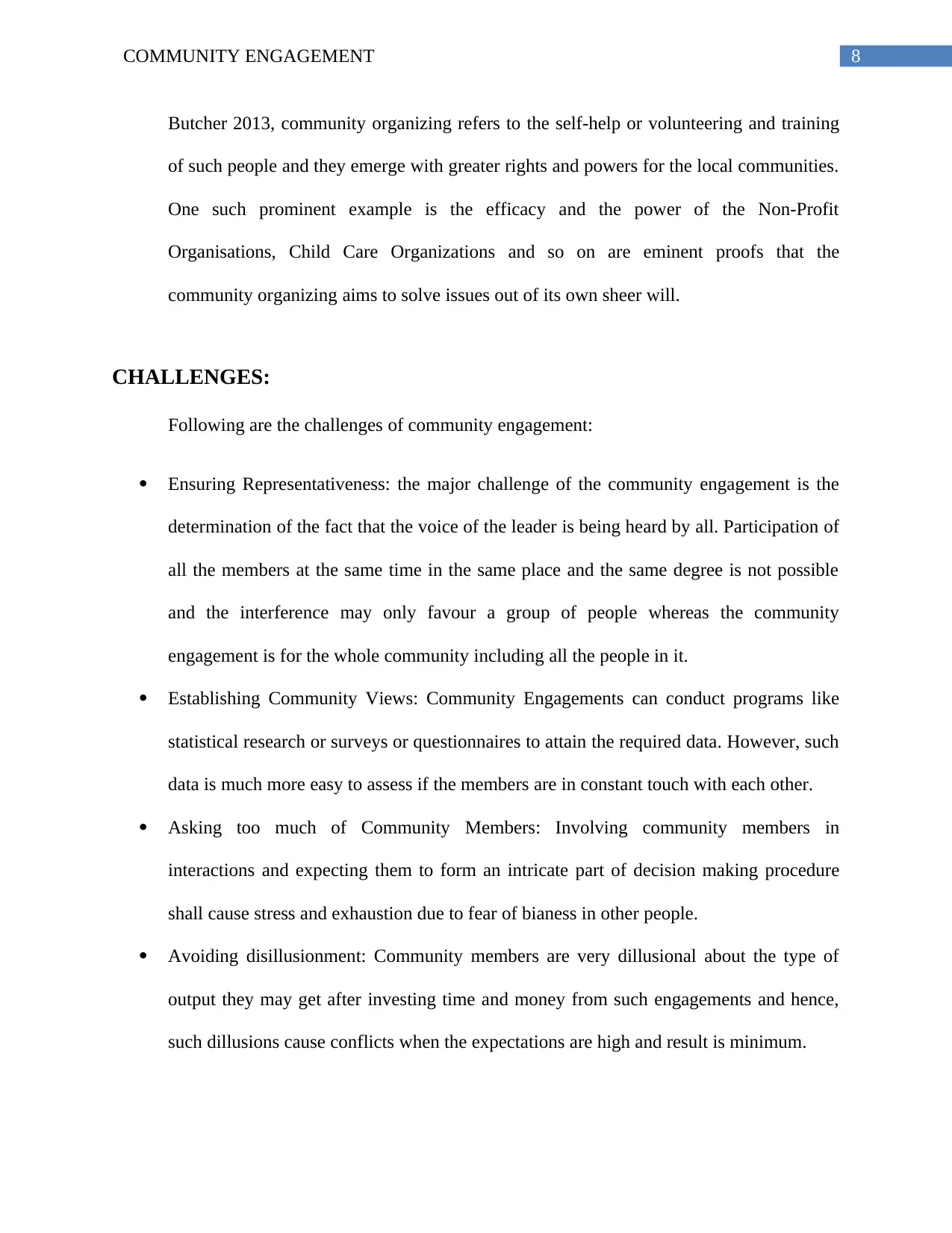
8COMMUNITY ENGAGEMENT
Butcher 2013, community organizing refers to the self-help or volunteering and training
of such people and they emerge with greater rights and powers for the local communities.
One such prominent example is the efficacy and the power of the Non-Profit
Organisations, Child Care Organizations and so on are eminent proofs that the
community organizing aims to solve issues out of its own sheer will.
CHALLENGES:
Following are the challenges of community engagement:
Ensuring Representativeness: the major challenge of the community engagement is the
determination of the fact that the voice of the leader is being heard by all. Participation of
all the members at the same time in the same place and the same degree is not possible
and the interference may only favour a group of people whereas the community
engagement is for the whole community including all the people in it.
Establishing Community Views: Community Engagements can conduct programs like
statistical research or surveys or questionnaires to attain the required data. However, such
data is much more easy to assess if the members are in constant touch with each other.
Asking too much of Community Members: Involving community members in
interactions and expecting them to form an intricate part of decision making procedure
shall cause stress and exhaustion due to fear of bianess in other people.
Avoiding disillusionment: Community members are very dillusional about the type of
output they may get after investing time and money from such engagements and hence,
such dillusions cause conflicts when the expectations are high and result is minimum.
Butcher 2013, community organizing refers to the self-help or volunteering and training
of such people and they emerge with greater rights and powers for the local communities.
One such prominent example is the efficacy and the power of the Non-Profit
Organisations, Child Care Organizations and so on are eminent proofs that the
community organizing aims to solve issues out of its own sheer will.
CHALLENGES:
Following are the challenges of community engagement:
Ensuring Representativeness: the major challenge of the community engagement is the
determination of the fact that the voice of the leader is being heard by all. Participation of
all the members at the same time in the same place and the same degree is not possible
and the interference may only favour a group of people whereas the community
engagement is for the whole community including all the people in it.
Establishing Community Views: Community Engagements can conduct programs like
statistical research or surveys or questionnaires to attain the required data. However, such
data is much more easy to assess if the members are in constant touch with each other.
Asking too much of Community Members: Involving community members in
interactions and expecting them to form an intricate part of decision making procedure
shall cause stress and exhaustion due to fear of bianess in other people.
Avoiding disillusionment: Community members are very dillusional about the type of
output they may get after investing time and money from such engagements and hence,
such dillusions cause conflicts when the expectations are high and result is minimum.
⊘ This is a preview!⊘
Do you want full access?
Subscribe today to unlock all pages.

Trusted by 1+ million students worldwide
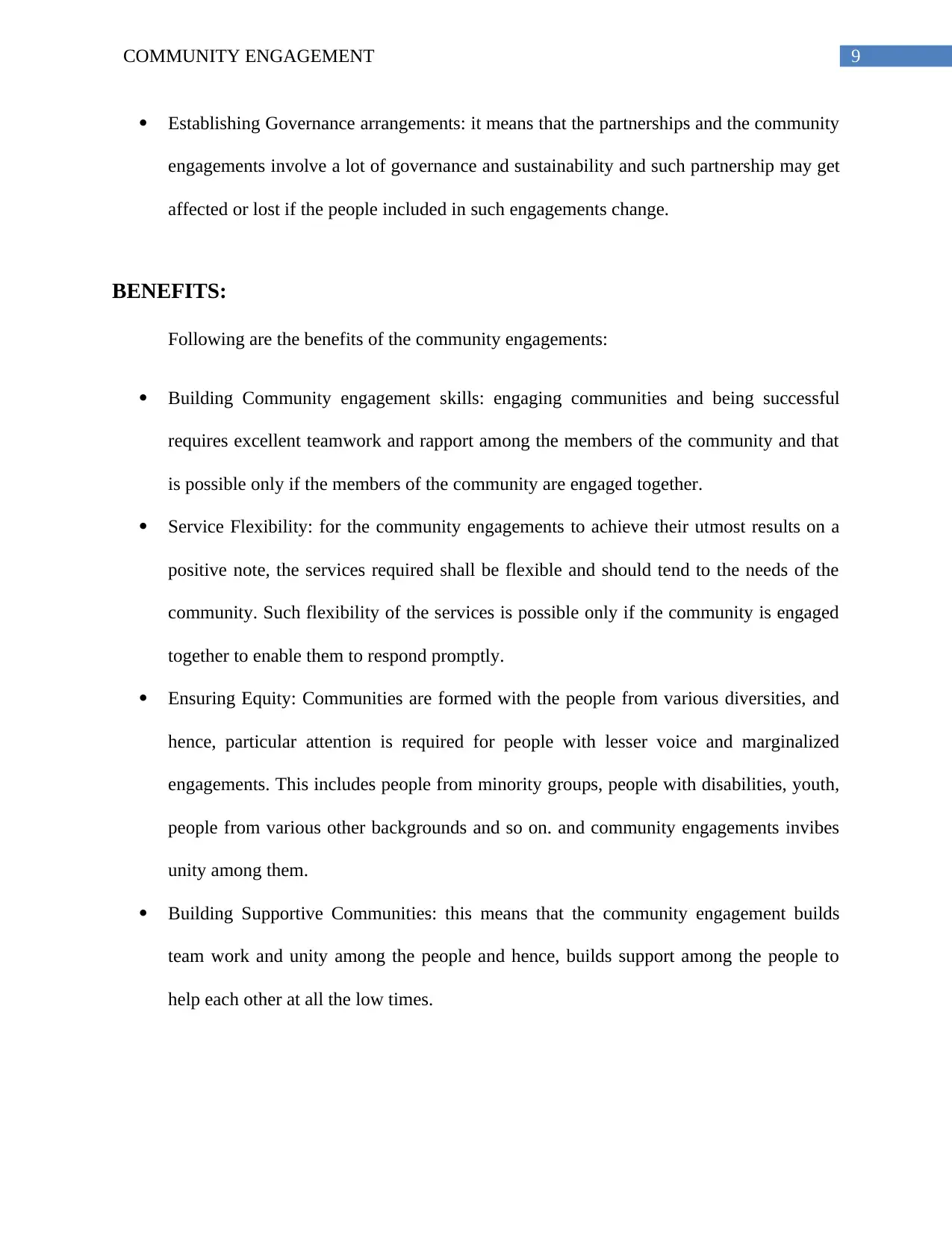
9COMMUNITY ENGAGEMENT
Establishing Governance arrangements: it means that the partnerships and the community
engagements involve a lot of governance and sustainability and such partnership may get
affected or lost if the people included in such engagements change.
BENEFITS:
Following are the benefits of the community engagements:
Building Community engagement skills: engaging communities and being successful
requires excellent teamwork and rapport among the members of the community and that
is possible only if the members of the community are engaged together.
Service Flexibility: for the community engagements to achieve their utmost results on a
positive note, the services required shall be flexible and should tend to the needs of the
community. Such flexibility of the services is possible only if the community is engaged
together to enable them to respond promptly.
Ensuring Equity: Communities are formed with the people from various diversities, and
hence, particular attention is required for people with lesser voice and marginalized
engagements. This includes people from minority groups, people with disabilities, youth,
people from various other backgrounds and so on. and community engagements invibes
unity among them.
Building Supportive Communities: this means that the community engagement builds
team work and unity among the people and hence, builds support among the people to
help each other at all the low times.
Establishing Governance arrangements: it means that the partnerships and the community
engagements involve a lot of governance and sustainability and such partnership may get
affected or lost if the people included in such engagements change.
BENEFITS:
Following are the benefits of the community engagements:
Building Community engagement skills: engaging communities and being successful
requires excellent teamwork and rapport among the members of the community and that
is possible only if the members of the community are engaged together.
Service Flexibility: for the community engagements to achieve their utmost results on a
positive note, the services required shall be flexible and should tend to the needs of the
community. Such flexibility of the services is possible only if the community is engaged
together to enable them to respond promptly.
Ensuring Equity: Communities are formed with the people from various diversities, and
hence, particular attention is required for people with lesser voice and marginalized
engagements. This includes people from minority groups, people with disabilities, youth,
people from various other backgrounds and so on. and community engagements invibes
unity among them.
Building Supportive Communities: this means that the community engagement builds
team work and unity among the people and hence, builds support among the people to
help each other at all the low times.
Paraphrase This Document
Need a fresh take? Get an instant paraphrase of this document with our AI Paraphraser
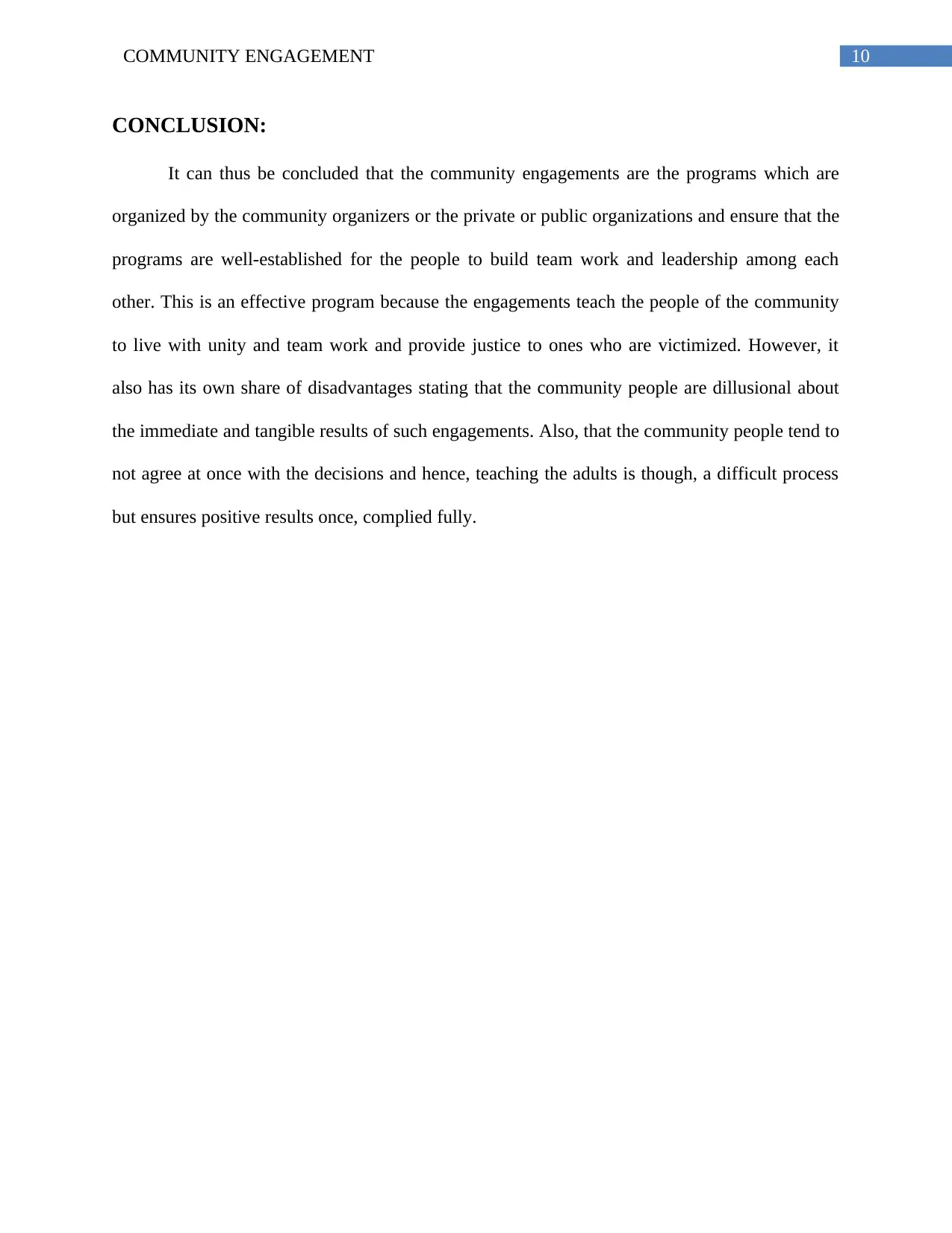
10COMMUNITY ENGAGEMENT
CONCLUSION:
It can thus be concluded that the community engagements are the programs which are
organized by the community organizers or the private or public organizations and ensure that the
programs are well-established for the people to build team work and leadership among each
other. This is an effective program because the engagements teach the people of the community
to live with unity and team work and provide justice to ones who are victimized. However, it
also has its own share of disadvantages stating that the community people are dillusional about
the immediate and tangible results of such engagements. Also, that the community people tend to
not agree at once with the decisions and hence, teaching the adults is though, a difficult process
but ensures positive results once, complied fully.
CONCLUSION:
It can thus be concluded that the community engagements are the programs which are
organized by the community organizers or the private or public organizations and ensure that the
programs are well-established for the people to build team work and leadership among each
other. This is an effective program because the engagements teach the people of the community
to live with unity and team work and provide justice to ones who are victimized. However, it
also has its own share of disadvantages stating that the community people are dillusional about
the immediate and tangible results of such engagements. Also, that the community people tend to
not agree at once with the decisions and hence, teaching the adults is though, a difficult process
but ensures positive results once, complied fully.
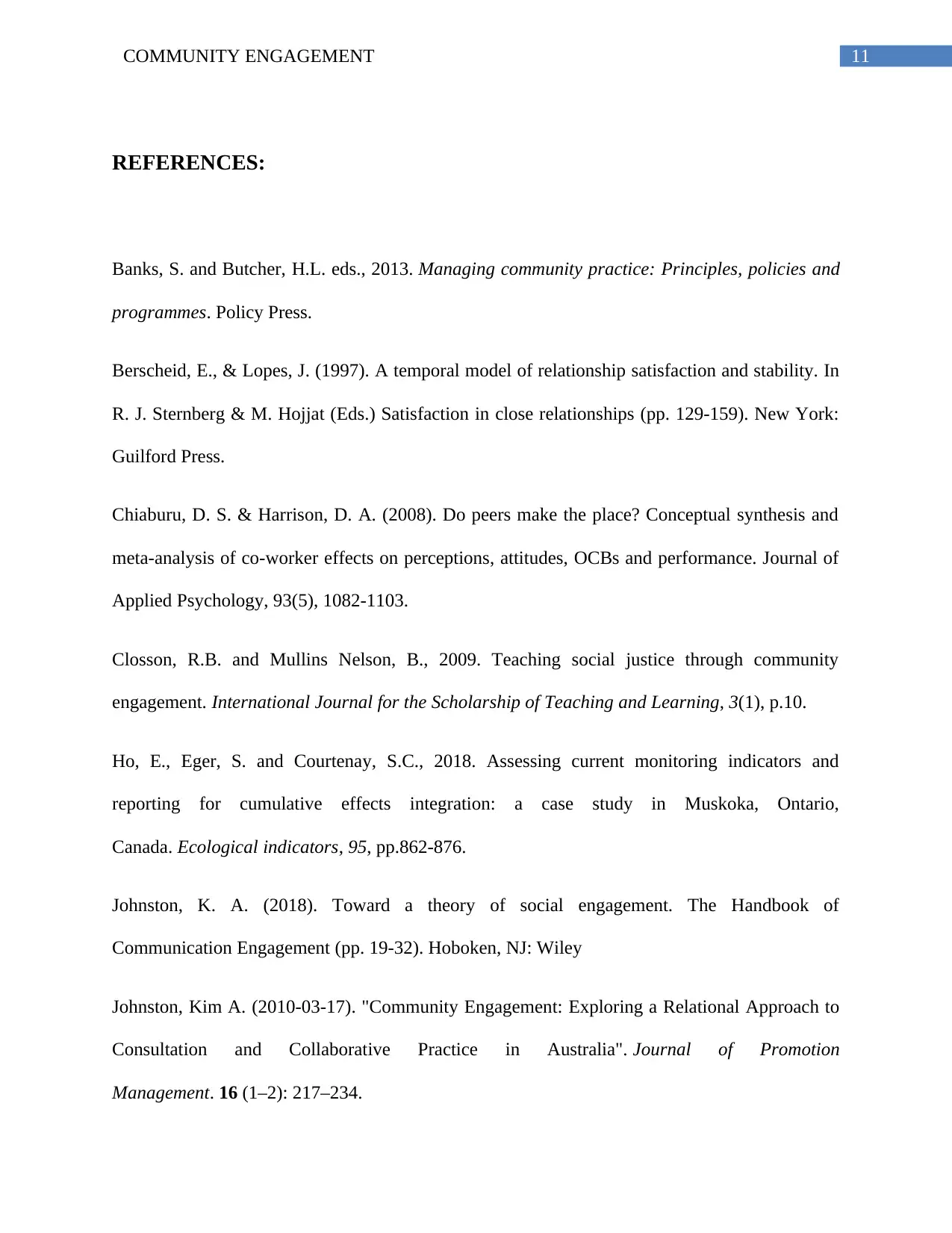
11COMMUNITY ENGAGEMENT
REFERENCES:
Banks, S. and Butcher, H.L. eds., 2013. Managing community practice: Principles, policies and
programmes. Policy Press.
Berscheid, E., & Lopes, J. (1997). A temporal model of relationship satisfaction and stability. In
R. J. Sternberg & M. Hojjat (Eds.) Satisfaction in close relationships (pp. 129-159). New York:
Guilford Press.
Chiaburu, D. S. & Harrison, D. A. (2008). Do peers make the place? Conceptual synthesis and
meta-analysis of co-worker effects on perceptions, attitudes, OCBs and performance. Journal of
Applied Psychology, 93(5), 1082-1103.
Closson, R.B. and Mullins Nelson, B., 2009. Teaching social justice through community
engagement. International Journal for the Scholarship of Teaching and Learning, 3(1), p.10.
Ho, E., Eger, S. and Courtenay, S.C., 2018. Assessing current monitoring indicators and
reporting for cumulative effects integration: a case study in Muskoka, Ontario,
Canada. Ecological indicators, 95, pp.862-876.
Johnston, K. A. (2018). Toward a theory of social engagement. The Handbook of
Communication Engagement (pp. 19-32). Hoboken, NJ: Wiley
Johnston, Kim A. (2010-03-17). "Community Engagement: Exploring a Relational Approach to
Consultation and Collaborative Practice in Australia". Journal of Promotion
Management. 16 (1–2): 217–234.
REFERENCES:
Banks, S. and Butcher, H.L. eds., 2013. Managing community practice: Principles, policies and
programmes. Policy Press.
Berscheid, E., & Lopes, J. (1997). A temporal model of relationship satisfaction and stability. In
R. J. Sternberg & M. Hojjat (Eds.) Satisfaction in close relationships (pp. 129-159). New York:
Guilford Press.
Chiaburu, D. S. & Harrison, D. A. (2008). Do peers make the place? Conceptual synthesis and
meta-analysis of co-worker effects on perceptions, attitudes, OCBs and performance. Journal of
Applied Psychology, 93(5), 1082-1103.
Closson, R.B. and Mullins Nelson, B., 2009. Teaching social justice through community
engagement. International Journal for the Scholarship of Teaching and Learning, 3(1), p.10.
Ho, E., Eger, S. and Courtenay, S.C., 2018. Assessing current monitoring indicators and
reporting for cumulative effects integration: a case study in Muskoka, Ontario,
Canada. Ecological indicators, 95, pp.862-876.
Johnston, K. A. (2018). Toward a theory of social engagement. The Handbook of
Communication Engagement (pp. 19-32). Hoboken, NJ: Wiley
Johnston, Kim A. (2010-03-17). "Community Engagement: Exploring a Relational Approach to
Consultation and Collaborative Practice in Australia". Journal of Promotion
Management. 16 (1–2): 217–234.
⊘ This is a preview!⊘
Do you want full access?
Subscribe today to unlock all pages.

Trusted by 1+ million students worldwide
1 out of 14
Related Documents
Your All-in-One AI-Powered Toolkit for Academic Success.
+13062052269
info@desklib.com
Available 24*7 on WhatsApp / Email
![[object Object]](/_next/static/media/star-bottom.7253800d.svg)
Unlock your academic potential
Copyright © 2020–2025 A2Z Services. All Rights Reserved. Developed and managed by ZUCOL.



